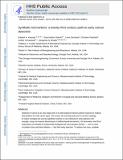Notice
This is not the latest version of this item. The latest version can be found at:https://dspace.mit.edu/handle/1721.1/142860.2
Synthetic biomarkers: a twenty-first century path to early cancer detection
| dc.contributor.author | Kwong, Gabriel A | |
| dc.contributor.author | Ghosh, Sharmistha | |
| dc.contributor.author | Gamboa, Lena | |
| dc.contributor.author | Patriotis, Christos | |
| dc.contributor.author | Srivastava, Sudhir | |
| dc.contributor.author | Bhatia, Sangeeta N | |
| dc.date.accessioned | 2022-06-01T19:42:09Z | |
| dc.date.available | 2022-06-01T19:42:09Z | |
| dc.date.issued | 2021 | |
| dc.identifier.uri | https://hdl.handle.net/1721.1/142860 | |
| dc.description.abstract | Detection of cancer at an early stage when it is still localized improves patient response to medical interventions for most cancer types. The success of screening tools such as cervical cytology to reduce mortality has spurred significant interest in new methods for early detection (for example, using non-invasive blood-based or biofluid-based biomarkers). Yet biomarkers shed from early lesions are limited by fundamental biological and mass transport barriers - such as short circulation times and blood dilution - that limit early detection. To address this issue, synthetic biomarkers are being developed. These represent an emerging class of diagnostics that deploy bioengineered sensors inside the body to query early-stage tumours and amplify disease signals to levels that could potentially exceed those of shed biomarkers. These strategies leverage design principles and advances from chemistry, synthetic biology and cell engineering. In this Review, we discuss the rationale for development of biofluid-based synthetic biomarkers. We examine how these strategies harness dysregulated features of tumours to amplify detection signals, use tumour-selective activation to increase specificity and leverage natural processing of bodily fluids (for example, blood, urine and proximal fluids) for easy detection. Finally, we highlight the challenges that exist for preclinical development and clinical translation of synthetic biomarker diagnostics. | en_US |
| dc.language.iso | en | |
| dc.publisher | Springer Science and Business Media LLC | en_US |
| dc.relation.isversionof | 10.1038/S41568-021-00389-3 | en_US |
| dc.rights | Creative Commons Attribution-NonCommercial-ShareAlike 4.0 International | en_US |
| dc.rights.uri | https://creativecommons.org/licenses/by-nc-sa/4.0/ | en_US |
| dc.source | PMC | en_US |
| dc.title | Synthetic biomarkers: a twenty-first century path to early cancer detection | en_US |
| dc.type | Article | en_US |
| dc.identifier.citation | Kwong, Gabriel A, Ghosh, Sharmistha, Gamboa, Lena, Patriotis, Christos, Srivastava, Sudhir et al. 2021. "Synthetic biomarkers: a twenty-first century path to early cancer detection." Nature Reviews Cancer, 21 (10). | |
| dc.relation.journal | Nature Reviews Cancer | en_US |
| dc.eprint.version | Author's final manuscript | en_US |
| dc.type.uri | http://purl.org/eprint/type/JournalArticle | en_US |
| eprint.status | http://purl.org/eprint/status/PeerReviewed | en_US |
| dc.date.updated | 2022-06-01T19:36:04Z | |
| dspace.orderedauthors | Kwong, GA; Ghosh, S; Gamboa, L; Patriotis, C; Srivastava, S; Bhatia, SN | en_US |
| dspace.date.submission | 2022-06-01T19:36:06Z | |
| mit.journal.volume | 21 | en_US |
| mit.journal.issue | 10 | en_US |
| mit.license | OPEN_ACCESS_POLICY | |
| mit.metadata.status | Authority Work and Publication Information Needed | en_US |
